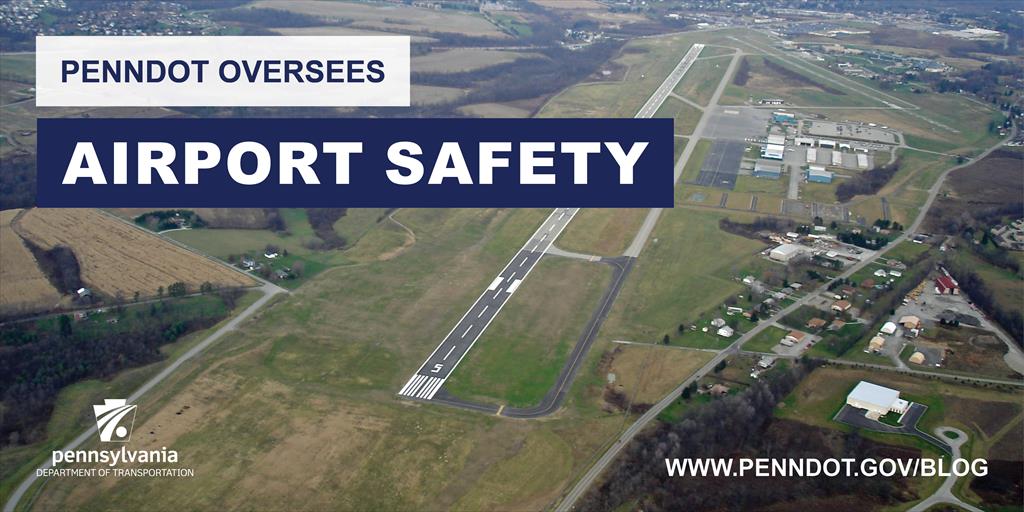
PennDOT's Bureau of Aviation oversees the safety of the 649 airports and heliports licensed within Pennsylvania. There are three main types of airports when it comes to how PennDOT determines how often to perform inspections. Here's a quick overview.

Nearly one-fifth (127) of those facilities are open every day to the public for recreation, business, and flight training. As such, the bureau dedicates a higher level of oversight to the public facilities, inspecting them every year for compliance with safety guidelines. Information obtained from these annual inspections is also used by the Federal Aviation Administration to update their aeronautical publications.
There are more than 244 privately operated airports located throughout the state. These facilities are typically for personal use only, and as such, the safety requirements are not as broad and can be tailored to the owner's unique situation. Private facilities are closed to the public unless prior permission is given by the owner. This provides owners an additional measure of control to limit use at their airport and assure that any hazards can be addressed prior to use. Safety inspections at private facilities are scheduled generally between every 3-10 years, depending upon the number of airplanes located at the site and type of activities occurring there.
Pennsylvania hosts approximately 120 hospital heliports and medical center heliports. These sites are also privately operated facilities, but due to the public nature of the flight operations, safety expectations are higher and inspections more frequent (every 2-5 years). The Bureau's safety team coordinates closely with hospital staff and medevac crews to assure the appropriate measure of managerial oversight is given to these landing areas.
Only five PennDOT teammates oversee the licensing and safety of all these facilities. They routinely interact with the FAA, airport and heliport owners, municipal and legislative officials, pilots, airport consultants, and concerned neighbors.
ABOUT THIS BLOG
Did you know PennDOT is directly responsible for nearly 40,000 miles of highway and roughly 25,000 bridges? We oversee programs and policies affecting highways, urban and rural public transportation, airports, railroads, ports and waterways, in addition to administering the state's more than 11 million vehicle registrations and 8.8 million driver's licenses.
So, how do we do what we do? And how can we help you travel in Pennsylvania — whether it be for business or leisure — in safe and enjoyable manner? Read PennDOT Way to learn more about the department, what we do, and how and why we do it.
TAGS
50-Year Anniversary, 511PA, Aggressive Driving, Airports, Autonomous Vehicles, Bicycles, Bridges, Child Safety, Community Relations, Construction, COVID-19, Distracted Driving, District 1, District 10, District 11, District 12, District 2, District 3, District 4, District 5, District 6, District 8, District 9, DOTcom, Driver and Vehicle Services, Emergency Responders, Employment, Equity, FAQ Friday, Human Trafficking, Impaired Driving, Innovations, Live Free Ride Alive, Maintenance Monday, Motorcycles, Older Drivers, PA Motorcycle Safety Program, Pedestrians, PennDOT Connects, Ports, Public Transit, Railroads, REAL ID, Road MaP, Roadside Beautification, Rural Roads, Safety, School Buses, Seat Belts, State Transportation Innovation Council (STIC), Sustainability, Teen Drivers, Throwback Thursday, Transportation Funding, Travel in PA, Welcome Centers, Winter, Work Smart, Work Zone, Yellow Dot
LATEST POSTS
PennDOT Continues Sharing, Updating Resources for Local Governments to Pursue Bipartisan Infrastructure Law Funding Opportunities
Norwin High School Wins 2024 ‘Innovations Challenge’
Demo Complete: I-95 CAP Project in Center City Philadelphia
PennDOT Archeologist Connects Past, Present, and Future
Lehigh Valley DUI, Highway Safety Task Force Hosts Law Enforcement Seminar
ARCHIVES
2024
2023
2022
2021
2020
2019
2018
2017

